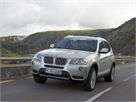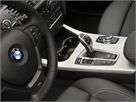Recent Articles
Popular Makes
Body Types
10 Things You Should Know About the 2011 BMW X3
Bigger, better and more powerful

BMW's defining trait is sportiness. It's hard to call an SUV sporty, so BMW has a different name for it, the Sport Activity Vehicle. BMW's two SAVs truly are sporty, but the first-generation X3 was sporty at the expense of ride quality. That rough ride, along with high prices, and a small backseat conspired to make the X3 perhaps the most unloved BMW, despite the fact that it was one of the first entry luxury crossover SUVs. New competition from the likes of the Audi Q5, Acura RDX and Volvo XC60 also cut sales from 34,000 in 2004 to just 6000 in 2009. BMW is aiming to reclaim those sales with a larger, softer and faster 2011 X3. Will these changes be enough? Let's find out. Photos courtesy of BMW
#10. The 2011 BMW X3 is as big as the first-generation BMW X5
The 2011 BMW X3 is 3.1 inches longer, and 1.1 inches wider than the outgoing model, while only gaining 55 pounds. With a 110.5-inch wheelbase, a length of 183 inches, and 74.1-inch width, the X3 is now as big as the first-generation X5, though not as heavy. Of course, the X5 has grown, too. When it was redesigned for the 2007 model year, it grew 7.4 inches longer and added an available third-row seat. By making the X3 bigger, BMW leaves room for a smaller five-passenger model at the bottom of the brand's SAV lineup. That model, the X1, is scheduled for release next spring.

#9. The 2011 X3 is offered in two models instead of one
Previously only available as one model called xDrive30i, the X3 is now offered in two models based on engine choice, xDrive28i and xDrive35i. Both use a 3.0-liter inline six-cylinder engine, but the 35i is turbocharged. Standard equipment includes leatherette upholstery, automatic climate control, eight-way power-adjustable front seats, memory for the driver's seat and mirrors, AM/FM/CD stereo with HD radio, auxiliary input jack, USB port, automatic headlights, fog lights, and P225/60R17 tires on alloy wheels. In addition to a more powerful engine, the xDrive35i adds xenon headlights, an alarm and P245/55R18 tires. Available options include a hard-drive-based navigation system, leather upholstery, a Head-Up Display, a panoramic sunroof, smartphone integration, a power tailgate, and a rear- and top-view camera. Both models come with the standard suite of safety features, including dual front airbags, front side airbags, curtain side airbags, active front head restraints, tire-pressure monitor, anti-lock brakes with brake assist, traction control, and electronic stability control. Hill descent control is also standard.

#8. The 2011 BMW X3 is quicker than the 2010
The X3 moves from one engine to two. The base 3.0-liter inline six in the xDrive28i model makes less power than last year's 3.0-liter but is actually quicker. It produces 240 horsepower and 221 pound-feet of torque, compared to 260 horsepower and 225 pound-feet in the 2010 model. A new eight-speed automatic transmission helps the engine operate at optimal efficiency more often, which contributes to a 0 to 60 mph time of 6.7 seconds compared to 7.1 seconds for the 2010 model with its six-speed automatic. The xDrive35i uses the eight-speed automatic and a turbocharged 3.0-liter inline six that churns out 300 horsepower and 300 pound-feet of torque. The turbo engine gives the X3 muscle car performance with a 0 to 60 mph time of 5.5 seconds. Power comes on smooth and strong without a whiff of turbo lag. Passing is a simple matter of a twitch of the right foot. While last year's manual transmission is no longer offered with either engine, xDrive35i drivers looking for a sportier experience can use a pair of easily accessed steering wheel shift paddles to choose their own gears.

#7. The ride in the 2011 X3 is much improved
The first-generation X3 was notorious for pounding over bumps and generally turning occupants' kidneys into gelatin. The changes BMW has made to the X3's structure and suspension have helped with the ride. The front suspension is similar to that of the 3 Series, with a pair of lower arms and a MacPherson strut on each side. The independent rear suspension changes from a three-link unit to a five-link. The X3 is also wider, which makes it more stable, and the body is more rigid. All of these traits allowed BMW to soften up the suspension settings, and that has paid off. Buyers who wouldn't consider the last model due to the hard ride can put the new one on their shopping lists as the ride is pleasingly forgiving. It deals with bumps much better, soaking them up instead of transferring their feel to occupants. It's still not as isolating as a Lexus, but we like the new combination of road feel and ride comfort.

#6. The 2011 X3 is the best-handling crossover SUV
The X3's noted sporty character hasn't suffered. It feels like an elevated sporty sedan and it moves like a vehicle weighing 1000 pounds less than its 4200-pound curb weight. The X3 is offered with a base suspension and an adjustable suspension called Electronic Damping Control (EDC). EDC is paired with Driving Dynamics Control, with has Normal, Sport and Sport Plus settings for the shocks, steering boost, transmission shift points, throttle response, and electronic stability control. While we like the base suspension for its balance of ride and handling, but EDC's Sport and Sport Plus settings have their uses. They keep the X3 even flatter in turns, firm up the steering, and make the throttle response quicker. Shifts, however, can feel abrupt instead of smooth, the revs stay high, and the throttle may become touchy. For those reasons, the Sport modes aren't good choices for city driving. Handling can also be enhanced by the Performance Control option for the xDrive all-wheel-drive system. In a turn, Performance Control applies the inside rear brake and sends more power to the outside rear tire to help the X3 corner.

#5. The 2011 X3 offers a cool new variable steering system
Buyers opting for Electronic Damping Control also get BMW's new Variable Sports Steering. It features a conical steering gear that makes the steering ratio quicker as the driver turns farther off center. This means that tight turns, like decreasing radius freeway on-ramps, require less steering movement, giving drivers more precise control. We like it, as well as the natural feel of the X3's steering. The steering is also nicely weighted, and the Sport and Sport Plus modes add a little more heft. Variable Sports Steering should not be confused with BMW's Active Steering, which varies ratio and assist depending on speed. While we like that system as well, some critics have complained that it's hard to tell when the ratio will change, making the steering unpredictable.

#4. Interior quality is up in the 2011 X3, and it's aided by some cool amenities
While the previous generation X3 interior didn't feel cheap, it was probably the lowest quality cabin in the lineup. BMW has made changes to address that for 2011, with some richer materials, a new design, and added contrast stitching. The result is typical BMW, with a substantial soft-touch dashboard, light or dark wood trim, sturdy plastics, and a quality feel. The look is a bit stark, especially when the black interior is chosen. The tan interior brakes up a monotonous dashboard look with more color. Unfortunately, leatherette upholstery is standard. Real leather is a $1450 option. Some new standard and optional features also raise the level of luxury and convenience. Newly standard are Bluetooth cell phone connectivity and a USB port to link to iPods and other MP3 players. A newly optional Head-Up Display can show navigation directions, speed and current gear on the windshield in the driver's line of sight. The navigation system is now hard-drive instead of DVD-based, and it has space to hold thousands of music files. Finally, the optional top- and rear-view camera aid visibility when parking and backing up.

#3. For 2011, the X3 gets the latest version of iDrive
Like other BMWs, the X3 gets the fourth generation of the iDrive entertainment and communication system as standard equipment. It is offered with an 8.8-inch screen and now incorporates several buttons around the central rotating controller. It also adds eight programmable memory buttons on the center stack. The new Menu, CD, Tel, Radio, Nav, Back and Option buttons make accessing various functions easier, quicker and more intuitive. The programmable buttons look like radio presets and they can be used that way. However, they can also be used to program commonly used functions, such as favorite phone numbers, important navigation destinations, or even sound settings. While technophobes will probably never embrace systems like iDrive, they clean up the dashboard design and can be learned over time. We've used it often and find it useful, if not always easy.

#2. Space inside the X3 is improved for 2011
The 2011 X3 increased width and wheelbase help give it more useful space for passengers. There is one inch more rear legroom, which really makes a difference. The rear seat now has enough room to comfortably accommodate two adults or three children. While the ride height is raised slightly, it is very easy to get in and out, though access to the rear seat is somewhat blocked by small door openings. Front seat comfort is exemplary, with nicely contoured seats with lots of controls and a standard tilt/telescoping steering wheel. Cargo room is actually down 15 cubic feet, but we find it more useful. There is a healthy 27.6 cubic feet of space behind the second-row seats. Those seats fold down either 60/40 or 40/20/40 to open up 56.6 cubic feet of cargo space. That's par for the class, but less than many compact SUVs. However, we do like the versatile cargo cover. It can be placed behind the first- or second-row seats, and comes with a pull-out net that can be used to partition off the cargo area. That'll help keep the dog from slobbering on passengers.

#1. The 2011 BMW X3 is a better value than before
The xDrive28i starts at $37,625, $2100 less than last year's xDrive30i while also adding Bluetooth connectivity, a USB port and an alarm. The xDrive35i is priced at $41,925, which BMW says is two percent less than the outgoing model based on equipment. Combine those lower prices with a better ride, improved rear seat room, and more power, and the 2011 BMW X3 is a better value than the outgoing model. Also consider the best-in-class driving dynamics, and the new X3 should reclaim some of the sales it has lost. Still, the competition is quite strong and the X3 isn't cheap, so it may never recapture the sales it had when it was basically in a class by itself.
